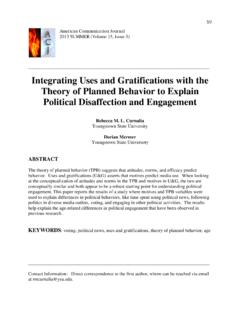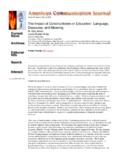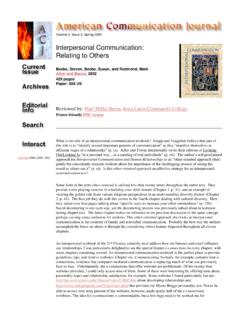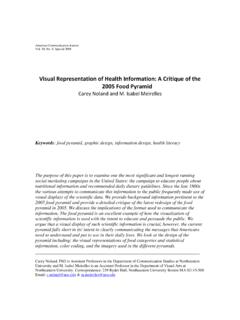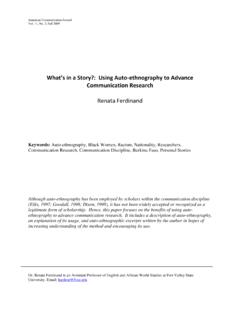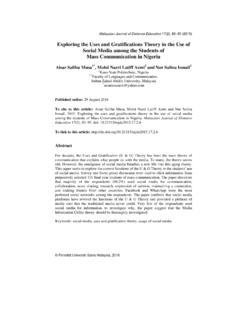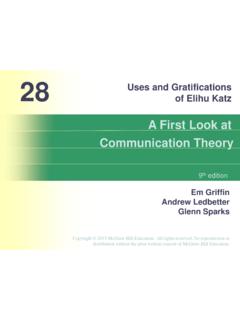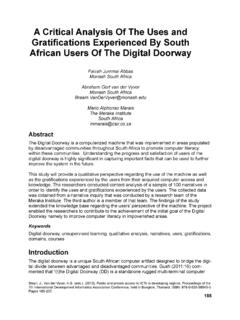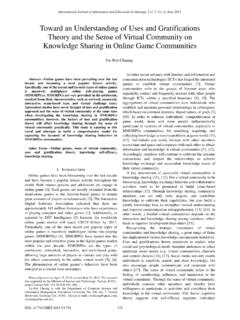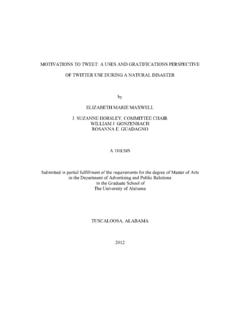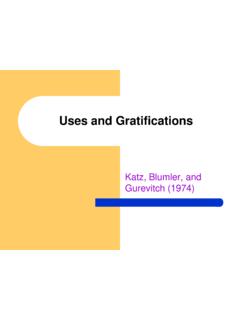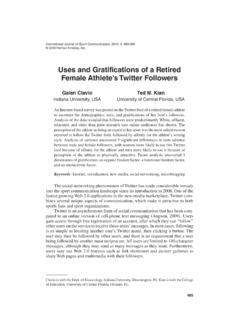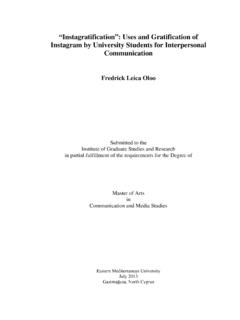Transcription of Consuming television crime drama: A uses and ...
1 TV crime Dramas 47 47 _____ Consuming television crime drama : a uses and gratifications Approach Darrin Brown University of Ontario Institute of Technology, Canada Sharon Lauricella University of Ontario Institute of Technology, Canada Aziz Douai University of Ontario Institute of Technology, Canada Arshia Zaidi University of Ontario Institute of Technology, Canada ABSTRACT This article employs uses and gratifications theory to conduct an audience analysis on crime drama viewership. To the best of our knowledge, this theory has not yet specifically been applied to this genre, thus providing a basis for the research study. Three independent variables (age, sex, frequency of crime drama viewing) were tested against four dependent variables (curiosity/information, identification, social interaction, and entertainment), as well as all variables together (full gratification) in order to determine if they were statistically significant predictors of each specific type of gratification.
2 Results indicated that frequency of viewing crime dramas was a statistically significant predictor for only full gratification and curiosity/information. The study s limitations and future research directions are discussed. _____ Authors can be reached at UOIT, Faculty of Social Science and Humanities, 2000 Simcoe Street North, Oshawa, ON, L1H7K4, Canada American Communication Journal 2012 WINTER (Volume 14, Issue 1) TV crime Dramas 48 48 Research on crime dramas and crime reality shows has been steadily growing for over three decades. Such programming has been studied in a variety of contexts; the most popular approaches include the relationship of crime dramas and reality shows to fear of crime , consistent inaccuracies that such programs portray, and the effects that such programs have upon viewers. This paper takes a unique approach to the study of crime drama viewership by employing a uses and gratifications theoretical approach to conduct an audience analysis of crime drama programming.
3 This approach is meaningful given scholarly debate on how this kind of programming does (or does not) affect viewers ( Gerbner & Gross, 1976; Doob & Macdonald, 1978; Fishman & Cavender, 1998). Rather than analyzing potential effects of this media, the study explores why individuals watch crime dramas so that we can better understand the relationship between television programming and the audience members who watch it. Millions of viewers across North America view crime dramas and crime reality shows weekly (Fishman, & Cavender, 1998). crime dramas such as Law and Order and NYPD Blue, as well as crime reality shows such as America s Most Wanted and Cops have been markedly successful (Cavender, & Bond-Maupin, 1993; Doyle, 1998; and Eschholz, Mallard, & Flynn, 2004). More recently, Nielsen ratings have suggested that NCIS, NCIS: Los Angeles, The Mentalist and Criminal Minds are the most popular crime dramas amongst viewers, and these programs ranked #5, #6, #7, and #8, respectively, in the Nielsen ratings at May, 2011 ( ).
4 Nielsen ratings are, according to Fishman (1998), the most complete measure of television viewing, and given that crime dramas constitute four of the top 10 ranked programs, this genre of programming is significantly popular in North America. Early research conducted on crime and the media was characterized by Gerbner and colleagues research on cultivation theory . According to Gerbner and Gross (1976) television is a medium of the socialization of most people into standardized roles and behaviours. Its function in a word, enculturation. (p. 175). In other words, according to Gerbner, individuals who watch more television (four or more hours daily) are more likely to perceive the world to be a mean and scary place (Sparks, 1992). Despite the initial acceptance of cultivation theory , one of the major criticisms of this theory is that it presupposes a homogenous audience that is passive and impacted in uniform ways during the television viewing process.
5 Ericsson (1991) notes that research indicates that people learn about crime and legal control from a wide variety of other sources, [and] that the mass media are but one source among many (p. 219-220). Gerbner s theory that those who watch four or more hours of television daily are more fearful of crime has been debated. For example, Doob and Macdonald s (1978) research on Toronto residents found that when neighbourhood incidence of crime was controlled for, there was no relationship between television viewing and fear of being a victim of crime . Another study by Heath and Petraitis (1987) found that the total amount of television viewing was related to fear of crime in distant urban settings ( , New York) but not within one s own city or neighbourhood. Further, Wober (1978) attempted to support Gerbner s theory in a study conducted in Britain and was unsuccessful. Wober suggested that, it should be accepted, therefore, that there is no evidence for a paranoid effect of television on British viewers, although the proposition has twice, and adequately, been put to the test (p.)
6 320). Similarly, Ditton, Chadee, Farrall, Gilchrist, and Bannister (2004) found no relationship between television viewing and fear of crime in their study and therefore propose that any relationships that have TV crime Dramas 49 49 been found in the past are weak and arbitrary. Eschholz, Chiricos, and Gertz (2003), when considering a full sample of viewers, found that television viewing was unrelated to fear of crime . Given the lack of empirical support to Gerbner s theory (Sparks, 1992), scholars have considered alternative explanations for the relationship between television viewing and fear of crime . There is a growing body of literature which, in contrast to Gerbner s theory , suggests that audience traits are important in the relationship between television viewing and fear. Some recent studies have shown that perceived racial composition of one s neighbourhood mediates the television viewing and fear of crime relationship.
7 Dowler (2003) found that perceived neighbourhood problems were related to fear of crime in his sample. Also, Eschholz, Chiricos, and Gertz (2003) concluded that people s perceived racial composition of neighbourhood is critical in the structuring of the television viewing and fear relationship; television effects were found for several different shows in areas where black populations were believed to be over 25 percent. Further, Moeller, (1989) found that whites living in mostly black neighbourhoods were more fearful crime (only sex and community size were better predictors). In sum, the relationship between television viewing and fear of crime (becoming a crime victim) is much more complex than once believed. It is therefore increasingly important to analyze the audience and why crime dramas are so appealing, rather than assuming that the media affects the audience in a homogenous manner. Doyle (2006) calls for scholars to think less about the effects of media, and more about the audience watching such programming.
8 uses and gratifications (U & G) theory parts ways with the hypodermic needle approach, as developed by Gerbner and colleagues. This approach assumed a homogenous audience in which the audience was passive during the viewing process. In contrast, U & G theory posits that the audience uses media outlets in order to satisfy certain needs and desires (Rubin, 1993). In other words, individuals actively seek out certain forms of media in a goal-directed and rational way that will provide them with the gratifications for which they are longing. According to Blumler and Katz (1974) the gratifications that individuals experience from media use are both psychological and social in nature. U&G theory creates a conceptual shift in focus from what the media does to people, to what people do with the media (Rubin, 1993). One of the central premises of U & G is that in order to explain the effects of media use, the motivation and behaviour of the individual must be understood (Rubin, 1993).
9 In McQuail s work (1984, 1987), four major categories to individual media use have been offered. They include: information (such as finding out about relevant events); personal identity (including finding reinforcement for personal values and finding models of behaviour); integration and social interaction (such as indentifying with others and gaining a sense of belonging); and entertainment (wanting to escape or be diverted from problems, or to simply relax or fill time). McQuail s categories are helpful in categorizing the motivations of the audience while viewing crime dramas. There have been several studies that have examined the audience of violent media in the context of a U&G framework. For example, Greene & Krcmar (2005) found that sensation seeking, verbal aggressiveness, argumentativeness, and instrumental androgyny were associated with exposure to violent films and, to a lesser degree, violent television .
10 Similarly, Slater (2003) showed that sensation seeking was an important predictor for attraction to violent television and TV crime Dramas 50 50 internet viewing. Further, Krcmar and Greene (1999) determined that high sensation seekers were more attracted to real life crime shows. On a similar note, Conway and Rubin (1991) concluded that sensation seeking was related to the constructs of passing time and escapism as motivations for television viewing. Within a U&G framework, these aspects (passing time and escapism) would be classified under McQuail s (1987) entertainment category. U & G continues to have an observable appeal largely because of its applicability to new research areas in communication. This can be seen through the recent studies on internet blog use (see Chung & Kim, 2007; Li, 2007). The U & G approach is considered one of the most appropriate theories by which to gain insight into an audience s psychology and behaviour (Li, 2007).
